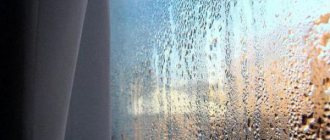In private homes, as in any other residential premises, it is very important to create and maintain comfortable microclimatic parameters. The air should be heated to the optimal temperature and saturated with moisture at a level of 40-60%. It is also important to pay attention to the organization of the ventilation system (in accordance with DBN V.2.5-67-2013 standards). Otherwise, the air will stagnate, accumulate odors, and become heavy.
Errors in organizing air circulation lead to dampness. Since excess moisture is not removed outside, it accumulates in the air, creating an uncomfortable environment. When humidity is above 65%, the growth of pathogenic microflora sharply increases, building structures of the house are destroyed, finishing and furniture deteriorate.
Consequences of high humidity in the house
Breathing such air is dangerous to health: the immune system, working in a state of “constant combat readiness,” will sooner or later fail. The risks of respiratory and allergic diseases increase sharply. High humidity in the house is especially harmful for children. Their immune system is just beginning to form, so it is not ready for excessive stress. It is also not recommended to breathe waterlogged air for the elderly and people suffering from asthma and allergies.
Why is high humidity in an apartment dangerous?
We were prompted to write this article by the story of one of our employees. She had an apartment in the city center, where she did a good renovation. After about six months, the woman noticed that she and her young child were often sick, and red, scaly spots began to appear on her body. Trying to understand the cause of the rash, she took an allergy test, which showed that the allergen was black mold.
Then our employee remembered that, indeed, the apartment felt damp and there was mold in some places, which she simply cleaned with a damp cloth. As a result, the situation was greatly neglected. She did not want to waste time dealing with dampness in the apartment and simply sold it at a price an order of magnitude lower than the market value. And this is a good example of what not to do.
Black mold on walls and furniture is the result of high humidity in the room
Therefore, if you notice that you have high humidity in your apartment, start taking action immediately. After all, from too humid indoor air:
- Even high-quality furniture deteriorates prematurely;
- household appliances break down;
- the decoration of the apartment deteriorates (the paint is cracking, the wallpaper becomes moldy and peels away from the walls);
- an unpleasant smell of dampness appears;
- mold grows in corners, walls, furniture;
- residents get sick more often, they develop problems with the respiratory system and have an allergic reaction (rashes, cough, nasal congestion, etc.).
On a note! First of all, the human body, natural leather, wood and paper suffer from dampness.
The severity of the consequences of high humidity in a room depends on how much the permissible values are exceeded and how long the situation remains uncontrolled.
Waterproofing layer
The first line of defense against dampness is an effective waterproofing layer combined with a moisture barrier film, supported by a good system of pipes and rainwater drainage gutters, as well as a plumbing system.
Ventilation is key to preventing problems that cause condensation. An air flow corresponding to the volume of the room must be ensured by the design of the building itself through soffit fans and hollow (perforated) bricks; while exhaust fans will effectively remove warm and humid air generated by household activities such as cooking, washing clothes and bathing.
What should be the humidity in the apartment?
It is important to understand what humidity indicator is considered high. Relying only on personal feelings is not entirely correct. So, when the humidity is slightly higher than normal and the temperature in the room is above +24°C, you can feel like you’re in the tropics and think that the situation is critical. Or vice versa, the temperature in the room will be within normal limits, but the humidity will be much higher, but you may not notice it.
Temperature and relative humidity standards - from optimal to maximum permissible - are presented in the table based on the recommendations of GOST 30494-2011.
| Room | Air temperature, °C | Relative humidity, % |
| Living room | 18-24 | 40-60 |
| Adults' bedroom | 18-24 | 40-50 |
| Children's room | 18-23 | 45-60 |
| Kitchen | 18-26 | 40-60 |
| Bathroom | 18-26 | 40-60 |
| Study | 18-26 | 40-60 |
On a note! Optimal indicators for an apartment or house as a whole: humidity - 40-60%, air temperature - 20-23 ° C.
Humidity norm in winter and summer
Experimental studies of the impact of humidity levels on the human body have shown that optimal indicators also depend on the time of year. According to the adopted GOST and recommendations of experts:
- in winter (during the cold season), normal humidity is considered to be from 30 to 45%;
- in summer (during the warm period) the normal humidity in the apartment is 30-60%.
If the humidity in your apartment rises above 60% in winter and above 65% in summer, then this is a reason to take measures to reduce it.
On a note! During cold times, air humidity is lower because cold air retains water vapor less well than warm air.
For children
A child's body is even more vulnerable than an adult, therefore, if there is a child in the house, it is simply necessary to control the humidity.
Humidity standards for children:
- according to GOST 30494-2011 standards - from 30 to 45% in the warm season and from 30 to 60% in the cold season.
- according to the recommendations of many pediatricians, for example, Dr. Komarovsky , the ideal humidity for a child is 50-60%. A figure above 70% will be critical.
Why does this happen?
An apartment or private house often suffers from two or even more reasons. And increased humidity on the walls can appear at different times of the year. For example, in winter it is typical:
- Freezing of walls;
- Poor ventilation;
- Mold.
And at other times of the year, high humidity inside and outside the home is most common.
Now in more detail. Why does the problem of damp walls in the house arise?
External moisture
This problem is typical for apartments located on upper floors with a poor drainage system.
How to determine air humidity in an apartment
If you have high air humidity in your apartment, you will most likely notice it by the following signs:
- Condensation forms on the windows - “the windows are crying”;
“Crying” windows are one of the indicators of high humidity in an apartment
- the bed seems damp;
- things in the closets smell damp;
- things in the room take too long to dry;
- book pages are damp;
- when the air temperature in the room rises even slightly, it becomes very stuffy;
- mold on furniture and decoration.
Important! A special device will help determine the level of humidity in an apartment - a non-contact hygrometer or a household weather station.
The hygrometer shows air humidity, sometimes temperature and other important indicators
The device shows the relative humidity in the room. Relative humidity is expressed as a percentage and indicates how far the steam is from saturation. To put it simply, steam is far from saturation (formation of water droplets) - the humidity is low, steam is close to saturation - the humidity is high.
This indicator is often confused with absolute humidity, but it only indicates the water content of the air by mass. It has been proven that a person does not feel this measure, but perceives the moisture content in the air as a ratio to the maximum possible value. That is, it is relative humidity that is important for us.
The humidity indicator will always be in sight if you hang a clock with a weather station on the wall.
buybuy
Wall clock with a built-in hygrometer and thermometer - the ability to always control the comfortable atmosphere in the room
If you don’t have a hygrometer, but want to measure humidity urgently, then you can use improvised means .
1. A fir cone with slightly straightened scales will show whether the air in your room is dry or humid. To do this, place it away from heating devices overnight. If the air is dry, the scales of the cone will open; if the air is humid, they will close.
Humidity by fir cone - a simple folk method, but the most reliable
2. Pour cold water and leave it in the refrigerator for an hour. Then take out the glass and place it in the room (again, away from heating devices). Due to temperature changes, condensation forms on the walls. If these drops of water dry within 15 minutes, then the air in the room is dry. If the drops do not dry for a long time, but flow down, the air humidity is increased. The condensation does not evaporate quickly, but does not flow down either - the humidity is within normal limits.
The humidity in the room is high if condensation flows in drops along the walls of the glass
How to determine air humidity by dew point
Dew point is a concept that should not be overlooked when talking about air humidity.
Important! Dew point is a measure of the temperature at which steam turns into water droplets. Depends on temperature and humidity.
In a room with dry air, the temperature must drop significantly for the steam to turn into condensation. Conversely, with high air humidity, the slightest drop in temperature leads to water vapor condensing and droplets forming - dew.
Knowing the air temperature and relative humidity in the room, you can easily determine the dew point value using the table below.
Determining the dew point is important to prevent the formation of dampness
Determining the dew point allows you to understand what ratio of temperature and air humidity will lead to the formation of dampness and mold. For example, the air temperature in the room is +21°C, and the relative humidity is 70%. Then point 15 will be critical. If the temperature on any surface of the room drops to +15°C, then moisture will immediately form on it.
The most vulnerable places in an apartment are windows and corners adjacent to the street. This is where the dew point is most often reached, so insulation and sealing should be considered first.
The dew point value also affects the human body. Which indicator is well tolerated and which requires adjustment, see the table.
The table helps you understand what dew point value you should strive for
When indoor humidity exceeds 60%, constant monitoring and measures to reduce it are required.
Where to contact
If all possible options for eliminating dampness do not help, then you need to write and submit a statement to the management company. In 2022, it will be drawn up in writing and in two copies. The paper should contain detailed information about when the corners or walls began to get wet, and an exact indication of the location.
ATTENTION! After submitting your application, it is important to ensure that it is recorded. The applicant must keep one copy with a mark.
The next action of the management company should be to send a technician to inspect the residential premises, based on the results of which a report on the presence of dampness and the reasons for its occurrence will be drawn up. The apartment owner must request a copy of this document.
As soon as the act is drawn up, the management company must decide on the option for repair work, as well as the time frame by which it will be completed. It is advisable for the apartment owner to take a copy of each document. If the repairs are not carried out or the period is significantly delayed, then these copies can be contacted with the relevant authorities.
Sample application to the Criminal Code
Sample complaint to the Housing Inspectorate
Then you can file a complaint with the housing inspectorate. It can also be submitted collectively, where all participants sign and the date is indicated. Such a complaint is considered within 30 working days. However, practice shows that it is considered in a shorter period of time. Most often this happens within 14 days.
Sample application to the Prosecutor's Office
The next authority you can subsequently contact is the prosecutor's office. A complaint to this body must be made in free form. As a rule, it is filled out in an official business style.
Obscene language and the use of jargon are unacceptable. And also you shouldn’t rate the problem. You need to restrain your emotionality. The government agency has the right to leave such applications without consideration.
Another important point is that errors, whether punctuation or spelling, should not in any way affect the acceptance of the complaint. At the end there is a signature and date.
Sample application to the Court
The last authority to which you can turn is the court. It should finally resolve your problem. But most often it all ends in the previous organs.
Causes of high humidity
But before you deal with humidity in your apartment, it is important to understand why it formed. Main reasons:
1. Poor ventilation. According to building codes, ventilation ducts must be in every apartment. But in practice, they are often clogged with debris, installed incorrectly, and sometimes completely absent.
The photo shows an example of a separate ventilation system for a bathroom
2. Incorrect insulation. In this case, the thermal and waterproofing of the room is compromised. It will be too hot here in the warm season, and cold in the winter. The problem can only occur in one room, usually the corner one.
3. Builders' mistakes. Often, a lot of dampness appears after a good renovation in an apartment. Modern windows, seals, thick layers of plaster, plastic and other dense finishes provide airtightness, but make ventilation difficult. And if the builders violated the installation technology, then problems with dampness cannot be avoided.
4. Violation of thermal balance. The presence of such a problem can be noticed by the formation of constant condensation - on windows, walls and any other surfaces. The concept is closely related to the “dew point”, which we talked about a little higher. It’s good if the dew point does not fall within the boundaries of the apartment at all, but is located closer to the outside of the building.
The dew point directly depends on the correct insulation of the walls
5. A constant source of moisture in the apartment. This could be faulty leaking plumbing or heating pipes, a bathroom without ventilation, “crying” windows, or frequent cooking in the kitchen without a hood. Additional sources include indoor plants, an aquarium, and wet laundry that is dried in the apartment.
Leaking plumbing is the most common cause of dampness and mold.
6. External factors. Here we include causes that are difficult or impossible to eliminate, but their consequences can be corrected. This is a dilapidated roof (for the top floor) and leaks from neighbors, the location of the apartment above a basement or other room with high dampness, the presence of a nearby reservoir or groundwater leakage (for a private house).
You will see such smudges and mold on the ceiling if dampness comes from neighbors above or from the roof
Often there is not one reason, but several at once, then you will have to put in a little more effort.
On a note! The risk group includes corner apartments and those located on the ground floor. As well as houses built in damp places or near bodies of water.
Check your apartment for each factor on the list above. Having determined the cause of high humidity, you can begin to combat it.
Methods for creating a waterproofing layer
There are many ways to construct a waterproofing layer - from the use of rolled and mastic materials that are embedded in the brickwork, to polymer solutions pumped into the walls through special holes.
In theory, you can do this job yourself, but dealing with rising damp is rarely easy. Here it is worth seeking advice from professionals. If you have a mortgage on your home, the lender may also require guarantees that prevent you from doing the work yourself. The quality standards of this work are as important as the mortgage system used, so you need to choose a reputable company that offers insured guarantees.
How to dry a house from dampness: reducing humidity
You measured the humidity level in the apartment, and it turned out to be higher than normal. The reason has been identified. What's next? We recommend not only eliminating pockets of dampness, but carrying out systematic work. To do this, you will need proven ways to get rid of humidity in an apartment.
Eliminate all sources of moisture
For this:
- Check all pipes, plumbing, and radiators in the apartment for leaks. Eliminate them if necessary.
- Leaky pipes, flooding of the basement, problems with the exhaust system and roof - problems that must be solved by the management company or housing and communal services. Contact them with a corresponding statement.
- Do not dry clothes in the apartment.
- Consider getting rid of an aquarium if you have one and reducing the number of houseplants.
- Make sure the installed plastic windows and slopes are tight.
It will be difficult to notice leaking hidden pipes. But usually it can be seen on the ceiling of the neighbors below. Be sure to ask them if there are any leaks on their ceiling. Check for the same smudges on your ceiling, because the problem of dampness may come from your neighbors above.
Hidden pipes are usually hidden behind drywall. This is aesthetically pleasing, but inconvenient in case of leaks
Think about proper insulation
A wall that is too thin, poorly sealed seams and lack of good insulation will only aggravate the problem. Add to this poor heating and seasonal temperature fluctuations - and dampness cannot be avoided.
If the insulation is not done correctly, and there is an empty gap between the wall and the insulation layer, then it is in this gap that moisture will form. Sooner or later, the owners of such apartments have to think about what to do if there is high humidity in the apartment. Then they carry out the correct insulation, the dew point shifts to the level of the insulation, and the dampness gradually leaves the apartment.
Proper insulation is the key to the absence of dampness in the apartment
So, the following will help to radically eliminate the cause of dampness:
- insulation, waterproofing and sealing of walls from the outside and inside;
- waterproofing of floors (for the first floor).
Provide forced ventilation of the room
The ventilation may be clogged, blocked by household appliances, furniture or finishing materials. Or perhaps it simply cannot cope with the outgoing flow of moist air..
To eliminate poor ventilation:
- Check the existing system for draft. Clean hoods regularly from dirt. The shaft in the general system may also be clogged, then contact the management company with a request to clean the ventilation duct.
- Be sure to turn on the kitchen hood while cooking.
Turn on the hood in the kitchen, even if you are just boiling the kettle
- Install a check valve on each vent. Sold separately and complete with fan and grille.
Installing a check valve on the hood will help combat high humidity
- Install duct fans in the duct inlets in the bathroom and kitchen. The devices operate from the mains and provide forced air ventilation. Or a ventilation wall valve. The device is mounted in a wall with an exit to the outside.
The wall valve will create forced air ventilation
Watch a useful video on how to install a hood and ventilation with your own hands.
A regular fan can also help maintain the circulation of moist and dry air and reduce the accumulation of condensation. An interesting option is lamps with a fan. They not only perform a practical function, but also complement the interior.
Special devices
One of the most effective ways to get rid of humidity in your apartment is to install a dehumidifier. The device extracts moisture from the air and removes it in the form of condensate into a special container.
A dehumidifier helps reduce indoor humidity
When choosing a dehumidifier for your apartment, pay attention to the main parameters:
- Performance. It’s good if it is equal to the product of the area of the room by a factor of 0.7. That is, for a room with an area of 20 m², a dehumidifier with a capacity of at least 14 l/day will be optimal.
- Noise level. The indicator does not affect the result, but affects the comfort of household members. Dehumidifiers with noise levels greater than 45 dB can cause irritation and sometimes interfere with sleep.
- Air exchange. The device should process the air in the room 3-4 times per hour. For a room of 20 m², you should choose a dehumidifier with a capacity of 150 m³/h or more.
Conventional air conditioners with a dry function also do a good job of drying air. If the air temperature allows, then use the heater more often or turn on the heating if it is individual. .
Installation of film waterproofing
Any competent “do-it-yourselfer” can handle such work. Installing new waterproofing film involves removing the old floor tiles and installing new ones, which is a difficult but most effective method of waterproofing a cement floor.
The floor can also be insulated by laying down several layers of moisture-resistant polyurethane, but it is important that any leaking spots are completely sealed with hydraulic cement first. The third option is to apply a two-layer coating of rubberized bitumen mastic to the old surface, then make a sand-cement screed on this surface, which will raise the floor level by about 50 mm.
Whichever method you choose, the waterproofing material must run up the adjacent walls so that it comes into contact with the film insulation, if any exists. The problem of damp floors, caused by rising groundwater levels that typically affect basements, is more serious and requires structural waterproofing or basement waterproofing, which should definitely be done by a professional.
Installation of a waterproofing layer. The polymer waterproofing layer is pumped into holes drilled in line, spaced approximately 115 mm apart. Once injected into the wall, the polymer components are layered on top of each other to create a continuous, impenetrable barrier. When the liquid dries, the drilled holes are sealed with mortar; then the plastered surface can be painted.
How to get rid of the effects of dampness: odor and mold
High humidity in a house or apartment does not go away without leaving a trace. Usually it leaves behind unpleasant consequences - the smell of dampness and mold. The following measures will help get rid of them:
- Remove all contents of cabinets and nightstands. Wash and dry things well in the sun. Wipe the cabinets inside and out with a vinegar solution and leave to air for 2-3 days.
- Use a solution of bleach and water (ratio 1/10) to treat all mold-affected areas of the apartment.
- You can use hydrogen peroxide instead of bleach. Wipe the moldy surfaces with the solution, then wipe with a damp and dry cloth.
- Vinegar works well against mold and mildew. Using a spray bottle or rag, apply table vinegar to areas with black mold. Then rinse and wipe dry. Repeat the procedure once a week until the problem disappears.
- Use professional products: antifungal, anti-mold aerosols to disinfect premises
Professional antifungal agents will help get rid of mold
Sources of excess moisture inside the home
If, after conducting an experiment with glass, you are convinced that the reason for the appearance of dampness lies inside the apartment, you need to make a thorough inspection of it and analyze your own habits and actions.
- Those who do not have balconies, or those who simply do not have enough space, often have to dry their laundry by hanging it throughout the apartment. If this is done on an ongoing basis, you need to reconsider your habits;
- The presence of aquariums in an apartment can cause increased humidity, especially if they are not equipped with special covers;
- Excessive number of indoor flowers;
- The reason may be irregular ventilation or its complete absence;
- Clogged ventilation ducts;
- Blocking of ventilation due to improper installation of household appliances or its blocking with finishing materials;
- Violation of the integrity of water pipes, which leads to regular leakage of water. If the pipes are hidden in plasterboard boxes, it will be impossible to notice the leak. Go to your downstairs neighbors and inspect their ceiling to rule out this cause;
- Carefully inspect the ceiling in your apartment, especially in the bathroom. Perhaps it is not you who have a leak, but the neighbors above you;
- Incorrect installation of plumbing elements;
- Leaks in plastic window structures;
- Cold slopes.
What to do with raw things?
In damp apartments, as a rule, all things in closets and chests of drawers, sofa covers and bed linen are also damp. The bed feels cold and to the touch . In addition, a characteristic unpleasant odor appears. To get rid of it, you will have to wash all things with the addition of vinegar, dry them thoroughly, and then iron them with steam. You can put linen bags with salt or silica gel in cabinets and chests of drawers. But such actions will be effective only if the causes of dampness in the home have been eliminated and the microclimate has been normalized.
The article was written for the site.
Tags:Cleaning











